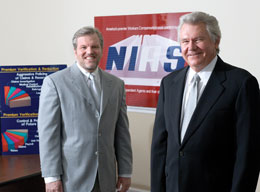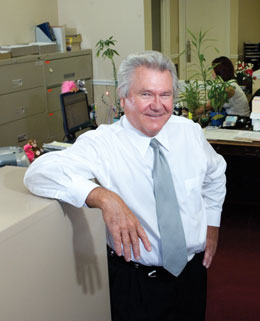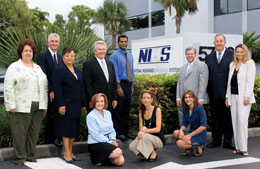|
Workers comp system provides differentiation to agencies
AcuComp helps agencies add value, save clients money
By Dave Willis
Vendors often tout exhaustive benefits that their products can deliver to end users. Not so with James B. “Jay” Conant, president of National Insurance Applications Systems, provider of the AcuCompSM workers compensation cost control system.
He says there’s really only one reason an insured would want to get involved with an agency that offers AcuComp: “To the end user, it will permanently reduce their workers comp premium, over time, an average of 28.5%.” That’s actually up from 27% just a couple of years ago. And Conant is confident in the numbers. “We measure results every year, across all agencies and all insureds,” he says.
Conant describes AcuComp as a data system that’s made up of hundreds of processes—all focused on changing the unit statistical plan filing data and changing the experience modifiers via insurer correction card filings with various rating bureaus.
Since the mid-1990s, AcuComp has documented tens of thousands of workers comp claim file reserve changes, generating nearly a quarter-billion dollars in claim file reductions, which lowered experience modifiers by an average of 28.5 points, he adds. The system and its results have actually been validated by a state insurance department, according to Conant.
Coming full circle
In the 1960s and ’70s, Conant owned a multiline agency. He sold that and in 1979 formed NIAS as a “rent a risk manager” operation. At that point, the initials actually stood for National Insurance Advisory Services. During the ’80s, as he became more familiar with state workers comp statutes, Conant uncovered a new opportunity to help companies audit their reserves. That led to the birth of AcuComp.
At first, AcuComp was bought and used only by industrial and commercial clients. But in the mid-1990s, an agency that had been referring problematic insureds to the vendor sought to use AcuComp to differentiate itself in a softening market. “They asked if we would consider selling them the service, so they could offer it as a wedge or point of differentiation in an increasingly competitive environment,” Conant recalls. After several months, he decided to give it a try. “We’ve been there ever since,” he says.
Today, AcuComp is offered strictly through privately held agencies nationwide, Conant says. Mandatory on-site training is provided at NIAS headquarters in Florida, and the system features a group of support professionals that handles all of the details for agencies that offer the system. “Our support group performs hundreds of tasks, ranging from data collection to claim file reserve reduction, unit statistical plan filing to correction card submissions,” Conant says. “And we track all of this through the experience modification rate process—through the tunnels and dungeons of all the rating bureaus.”
AcuComp staff reviews and evaluates open claims, making sure that reserves are at appropriate levels. As outstanding reserves are lowered, the experience modifier is reduced, resulting in lower premiums. The system allows agency support staff to monitor the experience modification factor for errors that result from improper reporting of claims and payroll data. And the firm provides regular reports to agents that show progress being made by insureds throughout the year.
Boosting agency business
While Conant cites just one reason why insureds would want to use AcuComp, he knows several reasons why agents use it. First, he says, it can permanently eliminate lead generation and prospecting challenges—the very thing the agency that approached him in the 1990s was seeking. Plus, he says, it helps increase closing ratios. Perhaps of most value is its ability to separate an agency from competitors.
Agent experience bears this out. Mark Stuart, CIC, president of Brennan & Stuart, an independent agency based in LaSalle, Illinois, uses AcuComp as part of what he calls a wheel of value-added services that the agency promotes. “The wheel is made up of a number of auditing services that focus on employee benefits, financial services, 401(k)s, and property and casualty,” he says.
AcuComp is an attractive part of the wheel—something his producers regularly use in presentations to prospects. Over a six-year period, the agency says, AcuComp has audited $17 million in incurred claims for agency clients and has reduced corresponding reserves by $5.4 million or nearly a third, via individual claim audits, experience mod audits or some related work. “We have a number of examples of clients that have saved in excess of $10,000, either getting a check back or getting an endorsement to the policy once a claim was reduced or some other error was corrected,” Stuart says.
These numbers hit home with prospects. “When we sit down with a prospect and start talking about our services and how we are different, they usually gravitate toward one portion of the wheel,” Stuart says. “On the P-C side, AcuComp has probably had the most impact.”
Stuart attributes some recent sales successes to AcuComp. One prospect—a group of sheltered workshop facilities that provide job opportunities for disabled individuals—was dealing directly with an insurer and wanted an audit of its workers comp program. “They were experiencing some reserve litigation problems,” Stuart recalls. “So we provided the audit and showed where we believed the problems were.” Stuart’s firm was quickly named broker of record for the account.
The other—a multi-location hospitality account—wanted the entire wheel of services. “We ended up taking over their 401(k), group insurance, workers comp, and property and casualty insurance,” Stuart says. The availability of AcuComp helped close the deal because the account was saddled with claim reserves that were several years old and weren’t getting closed. “They didn’t have a handle on where they were with their program and were unable to pinpoint why their experience mod was so high,” he adds. “The audits will take care of that.”
Chuck LaComb, senior vice president and director of sales at Haylor, Freyer & Coon, of Syracuse, New York, says AcuComp helps his organization sell, too. The agency, an Assurex Global partner, uses a sales process called The Wedge, which focuses, in large part, on differentiation and proactive service as a way to beat the competition. “AcuComp helps us ‘wedge’ our way into accounts, and bring something to the table prospects don’t already have,” he says.
This validates another feature that Conant says agents find useful. “It allows an agency to eliminate the incumbent agent without saying anything negative about him or her,” he says. “You know the old saying: ‘Point a finger at another person, and you have three pointing back at you.’ Perhaps the worst thing any agent could do is say something bad about the current agent. This is a way to take a broker of record letter without saying anything negative about the other person.”
Conant also says AcuComp can help agents shorten their selling cycle from months down to days—something LaComb’s agency has found to be true. “We met with an environmental contractor with a sizable comp premium and a mod that was over 120,” he recalls. The agency sent the contractor’s loss runs to AcuComp, which reformatted them, highlighting certain potential pain points. The agent went out to review the loss run with the client, pointing out particular claims that AcuComp had identified.
“One claim was still open, with a quarter-million dollar reserve on it, but the guy died two years earlier,” LaComb explains. “It had never been taken off of the run.” The agent got a broker-of-record letter that day.
Keeping clients happy
AcuComp also can help boost retention rates. Stuart says, “We have regularly scheduled claims review meetings with insureds, and we find that work done by AcuComp definitely helps from a retention standpoint.”
LaComb’s agency works with a large regional trade association, which it treats as one large client, a safety group with more than 100 members. “Because of the involvement of AcuComp and the work done on behalf of all the members, the reserve reductions account for a sizeable portion—up to 50%—of the dividends we pay back to the association,” he says.
When the competition comes knocking, agents often turn to AcuComp as a defensive tool. LaComb says, “When someone tries to move an account from us, we simply go back to the client and point out the benefits of the AcuComp system—something the competition doesn’t offer.”
Helping producers succeed
According to Conant, agencies often find that AcuComp helps agencies “grow faster, easier and in less time than ever before imagined.” Plus, he says, “It enables producers to meet 100% of expectations.”
LaComb has found that to be the case in his agency. “When people use it, it’s very effective,” he says. “But you have to build it into the sales process.
“If producers use all the tools that AcuComp provides, they write more business and retain more accounts,” he adds. “It’s a proven fact. Our top producers are the ones who use AcuComp. I can measure it again and again. The ones who don’t use it, don’t sell as effectively.” And that may be the best reason to give the system a look. *
For more information:
National Insurance Applications Systems
Phone: (800) 883-5600
Web site: www.niasgroup.com
The author
Dave Willis is a New England-based freelance writer and a regular contributor to Rough Notes magazine. |
|
Click on image for enlargement |
 |
| |
Left to right, William T. Threlkeld, NIAS, Inc.’s Information Systems Manager and Business Strategist, and James B. Conant, President of NIAS, Inc. |
| |
 |
| |
“It allows an agency to eliminate the incumbent agent without saying anything negative about him or her.”
—James B. “Jay” Conant |
| |
 |
| |
The management team of National Insurance Applications Systems, provider of the AcuComp workers compensation cost control system. |
|


